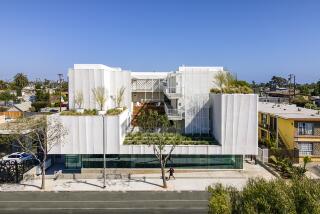Pasadena looks to slow down. Will it work?
The city of Pasadena in the coming months will be looking at a proposal that confounds conventional wisdom in a region preoccupied with time spent in cars: close some lanes on Colorado Boulevard, the city’s main thoroughfare, to slow down traffic.
The first thought that comes to mind is: Uh-oh, traffic jams — avoid downtown Pasadena. But the city might be on to something.
The proposal began with the Pasadena Playhouse District Assn., whose territory encompasses an asymmetrical area roughly between Green Street to north of Walnut Street, and from Los Robles Avenue east to Catalina Avenue. Colorado cuts east-west through the heart of the district, and the city, and is among the most traveled corridors in Pasadena.
GRAPHIC: Trimming down Colorado Boulevard
As The Times reported last week, over the last decade the neighborhood has added some 3,000 residential units within three blocks of Colorado Boulevard. Some new hotel proposals would add to the density — and the vitality.
The proposal is still in the formative stages, but it would narrow Colorado from two fast-moving lanes in each direction to one slow-moving lane each way (preserving a center left-turn lane), with diagonal parking and curbside “parklets” taking up the reclaimed space, plus right-turn lanes at the intersections. The parklets would be removable to ensure that the annual Rose Parade would be unimpeded.
Backers believe putting Colorado Boulevard on a road diet would increase pedestrian safety, slow traffic and give the area more of a community feel. A similar project underway in nearby Eagle Rock has narrowed Colorado from three to two lanes in each direction. But the Pasadena proposal takes the concept of “calming” traffic even further.
This is an idea worth pursuing, and studying. There are legitimate concerns about what the change would mean for traffic congestion on nearby streets. But with the 210 Freeway a few blocks to the north, there are other options for those wishing to drive through — rather than to — Pasadena.
That’s where the idea seems to have the most potential: crystallizing the district into a destination while diverting through-traffic around it. What would make it especially helpful, for both Pasadena and other Southern California cities, would be to build in some data-gathering to gauge the effects of these changes. Measuring street traffic — vehicle, bicycle and pedestrian — is obvious. But it also would be useful to collect sales transaction data from businesses in the area now, to measure against the post-diet transactions.
More walking, fewer cars: Pasadena could be building a better Main Street.
More to Read
A cure for the common opinion
Get thought-provoking perspectives with our weekly newsletter.
You may occasionally receive promotional content from the Los Angeles Times.









